Energy Consumption and Fume Analysis: A Comparative Analysis of the Blasting Technique and Mechanical Excavation in a Polish Gypsum Open-Pit Mine
Abstract
1. Introduction
2. Materials and Methods
2.1. Test Stand
2.1.1. Blasting Works
2.1.2. Mechanical Extraction
2.2. Materials
2.3. Equipment
2.4. Methods
2.4.1. Energy Consumption and Fumes
2.4.2. Prediction Model Method
3. Results and Discussion
3.1. Blasting Techniques
3.1.1. Evaluation of Explosion Energy of Energetic Materials
3.1.2. Evaluation of Energy Consumption of Loading and Drilling Operations
3.1.3. Evaluation of Energy Consumption of Loading and Drilling Operations
3.2. Mechanical Excavation
3.2.1. Evaluation of Mechanical Excavation’s Energy Consumption
3.2.2. Evaluation of the Fumes Generated by Mechanical Excavation
3.3. Comparison of Energy Consumption and Gas Emissions
3.4. Prediction Model Results
3.5. Theoretical Discussion on Environmental Impact
4. Conclusions
Author Contributions
Funding
Institutional Review Board Statement
Informed Consent Statement
Data Availability Statement
Acknowledgments
Conflicts of Interest
References
- Machniak, Ł.; Kozioł, W.; Borcz, A. Wytyczne wyboru efektywnych układów wydobywczych do produkcji kruszyw łamanych. Górnictwo Odkryw. 2013, 54, 95–101. [Google Scholar]
- Zou, D. Mechanisms of Rock Breakage by Blasting. In Theory and Technology of Rock Excavation for Civil Engineering; Springer: Singapore, 2016. [Google Scholar]
- Hamdi, E.; Romdhane, N.B.; Mouza, J.; Le Cleach, J.M. Fragmentation Energy in Rock Blasting. Geotech. Geol. Eng. 2007, 26, 133–148. [Google Scholar] [CrossRef]
- Lusk, B.; Silva, J.J. Energy Distribution in the Blast Fragmentation Process. In Energy Efficiency in the Minerals Industry. Green Energy and Technology; Awuah-Offei, K., Ed.; Springer: Berlin/Heidelberg, Germany, 2017. [Google Scholar]
- Pyra, J. Impact assessment of mining blasting operations for buildings. WUG Bezpieczeństwo Pracy i Ochrona Środowiska w Górnictwie 2008, 3, 41–47. [Google Scholar]
- Sanchidrián, J.A.; Segarra, P.; López, L.M. Energy components in rock blasting. Int. J. Rock Mech. Min. Sci. 2007, 44, 130–147. [Google Scholar] [CrossRef]
- Armaghani, J.D.; Hajihassani, M.; Monjezi, M.; Tonnizam, M.; Marto, A.; Moghaddam, M.R. Application of two intelligent systems in predicting environmental impacts of quarry blasting. Arab. J. Geosci. 2015, 8, 9647–9665. [Google Scholar] [CrossRef]
- Fişne, A.; Kuzu, C.; Hüdaverdi, T. Prediction of environmental impacts of quarry blasting operation using fuzzy logic. Environ. Monit. Assess. 2011, 174, 461–470. [Google Scholar] [CrossRef]
- Hidayat, S. Environmental impacts of open pit mining blasting: Particular discussions on some specific issues. J. Min. Environ. 2021, 1, 1–11. [Google Scholar]
- Jung, J.; Grabar, K. Methods for reducing the environmental impact of rock mass excavation. EnvEng-IO 2020, 7, 29–38. [Google Scholar]
- Kuzu, C.; Ergin, H. An assessment of environmental impacts of quarry-blasting operation: A case study in Istanbul, Turkey. Environ. Geol 2005, 48, 211–217. [Google Scholar] [CrossRef]
- Tomberg, T.; Toomik, A. Environmental impact of mine blasting. Environ. Technol. Resour. Proc. Int. Sci. Pr. Conf. 1999, 1, 213–219. [Google Scholar] [CrossRef][Green Version]
- Biessikirski, A.; Dworzak, M.; Twardosz, M. Composition of Fumes and Its Influence on the General Toxicity and Applicability of Mining Explosives. Mining 2023, 3, 605–617. [Google Scholar] [CrossRef]
- Goswami, T.; Brent, G. Blasting approaches to increase mine productivity and reduce greenhouse gas emissions in surface coal mining. In Proceedings of the 11th International Symposium on Rock Fragmentation by Blasting, Sydney, Australia, 24–26 August 2015; pp. 635–644. [Google Scholar]
- Kasztelewicz, Z.; Zajączkowski, M.; Sikora, M. Przegląd mechanicznych sposobów urabiania skał zwięzłych. Pr. Nauk. Inst. Górnictwa Politech. Wrocławskiej 2013, 43, 85–98. [Google Scholar]
- Kittipongvises, S. Assessment of Environmental Impacts of Limestone Quarrying Operations in Thailand. Environ. Clim. Technol. 2017, 20, 67–83. [Google Scholar] [CrossRef]
- Langer, W. Potential Environmental Impacts of Quarrying Stone in Karst—A Literature Review; U.S. Geological Survey Report; U.S. Department of the Interior, USGS Publishing Warehouse: Reston, VA, USA, 2001. [Google Scholar]
- Toraño, J.; Rodriguez, R.; Diego, I.; Menéndez, M. Environmental impact of rock excavation in urban areas: Comparison between blasting and hydraulic breaker hammer. Civ. Eng. Environ. Syst. 2006, 23, 117–126. [Google Scholar] [CrossRef]
- Amar, P.; Ramachandra, M.V.M.S.; Bahadur, S.K. Rock excavation using surface miners: An overview of some design and operational aspects. Int. J. Min. Sci. Technol. 2013, 23, 33–40. [Google Scholar]
- Ismael, M.; Abdelghafar, K.; Sholqamy, M.; Elkarmoty, M. Performance prediction of hydraulic breakers in excavation of a rock mass. Rud. Geološko-Naft. Zb. (Min. Geol. Pet. Eng. Bull.) 2021, 36, 107–119. [Google Scholar] [CrossRef]
- Pebrianto, R.; Asof, M.; Susilo, B.K.; Gofar, N. Evaluation of Factors Affecting Ripping Productivity in Open Pit Mining Excavation. Electron. J. Geotech. Eng. 2014, 19, 10447–10456. [Google Scholar]
- Cheenkachorn, K.; Poompipatpong, C.; Ho, C.G. Performance and emissions of a heavy-duty diesel engine fuelled with diesel and LNG (liquid natural gas). Energy 2013, 53, 52–57. [Google Scholar] [CrossRef]
- Huang, W.D.; Zhang, Y.H.P. Energy efficiency analysis: Biomass-to-wheel efficiency related with biofuels production, fuel distribution, and powertrain systems. PLoS ONE 2011, 6, e22113. [Google Scholar] [CrossRef]
- Kanfar, M.; Korman, T.; Kujundžić, T. Fuel consumption and engine load factors of equipment in quarrying of crushed stone. Teh. Vjesn. 2016, 23, 163–169. [Google Scholar]
- Okamoto, T.; Uchida, N. New Concept for Overcoming the Trade-Off between Thermal Efficiency, Each Loss and Exhaust Emissions in a Heavy Duty Diesel Engine. SAE Int. J. Engines 2016, 9, 859–867. [Google Scholar] [CrossRef]
- Ismail, M.A.M.; Kumar, N.S.; Abidin, M.H.Z.; Madun, A. Rippability Assessment of Weathered Sedimentary Rock Mass using Seismic Refraction Methods. J. Phys. Conf. Ser. 2018, 995, 012105. [Google Scholar] [CrossRef]
- Bęben, A. Teoretyczne Podstawy Mechanicznego Zwiercania Skał w Górnictwie Odkrywkowym; Wydawnictwa AGH: Kraków, Poland, 2012. [Google Scholar]
- Zhu, J.X.; Zhao, C.Y.; Zou, X.F. Identification of soil parameters on vibratory excavation of hydraulic excavator. Zhongnan Daxue Xuebao (Ziran Kexue Ban)/J. Cent. South Univ. (Sci. Technol.) 2006, 37. [Google Scholar]
- Zhu, J.X.; Zhao, C.Y.; Guo, X. Research on mechanism of vibratory excavation of hydraulic excavators. Yantu Lixue/Rock Soil Mechanics. 2007, 28, 537–541. [Google Scholar]
- Zhu, J.; Hu, H.; Mei, Y. Power consumption study on bucket vibratory excavation of hydraulic excavator. Tongji Daxue Xuebao/J. Tongji Univ. 2008, 36, 1408–1412. [Google Scholar]
- Boudiaf, M.; Chaib, R.; Talhi, K. Study of rippability in limestone quarries-case of the hadjar-soud quarry, Algeria. Phys. Chem. News 2010, 53, 39–44. [Google Scholar]
- Stewart, P.; Ramezanzadeh, A.; Knights, P. Benchmark Drill and Blast and Mechanical Excavation Advance Rates for Underground Hard-Rock Mine Development. In Proceedings of the Australian Mining Technology Conference, Hunter Valley, NSW, Australia, 26–27 September 2006; pp. 41–63. [Google Scholar]
- Wennmohs, K.H. Mechanical Rock Excavation versus Drilling and Blasting. GeoRecources J. Resour. Min. Tunn. Geotech. Equip. 2021, 2, 32–36. [Google Scholar]
- Feijóo, P.C. Comparative Analysis Between Drill and Blast and Mechanical Excavation in Underground Construction. Master’s Thesis, National Technical University of Athens, School of Mining and Metallurgical Engineering, Athens, Greece, 2019. [Google Scholar]
- Skawina, B.; Greberg, J.; Salama, A.; Schunnesson, H. Mechanical Excavation and Drilling and Blasting—A Comparison Using Discrete Event Simulation. Mine Plan. Equip. Sel. 2014, 367–377. [Google Scholar]
- Bascompta, M.; Sanmiquel, L.; Gangolells, M.; Sidki, N. LCA analysis and comparison in quarrying: Drill and blast vs mechanical extraction. J. Clean. Prod. 2022, 369, 133042. [Google Scholar] [CrossRef]
- EN 13631-16:2004; Explosives for Civil Uses. High Explosives. Part 16: Detection and Measurement of Toxic Gases. European Committee for Standardization: Brussels, Belgium, 2004.
- European Union. Council directive 93/15/EEC of 5 April 1993 on the harmonisation of the provisions relating to the placing on the market and supervision of explosives for civil uses. Off. J. Eur. Union 1993, 12, 20–36. [Google Scholar]
- Sadowski, A.; Żółtowski, B. Badania sprawności złożonych układów napędowych. Inżynieria I Apar. Chem. 2012, 5, 249–250. [Google Scholar]
- Winther, M.; Dore, C. EMEP/EEA Air Pollutant Emission Inventory Guidebook. 2023. Available online: https://www.eea.europa.eu/publications/emep-eea-guidebook-2023 (accessed on 1 August 2024).
- Harvey, A.C.; Shephard, N. Structural time series models. In Handbook of Statistics; Maddala, G., Rao, C., Vinod, H., Eds.; Elsevier: Amsterdam, The Netherlands, 1993; Volume 11, pp. 261–302. [Google Scholar]
- Harvey, A.C.; Peters, S. Estimation procedures for structural time series models. J. Forecast. 1990, 9, 89–108. [Google Scholar] [CrossRef]
- Taylor, S.J.; Letham, B. Forecasting at Scale. Am. Stat. 2018, 72, 37–45. [Google Scholar] [CrossRef]
- OZN Research. DCA 5 Detonation Calorimeter Product Datasheet. Available online: https://mueller-instruments.de/fileadmin/Downloads/instruments-medien/Detonationskalorimeter_-_DCA_5.pdf (accessed on 1 August 2024).
- Rai, R.; Singh, T.N. A new predictor for ground vibration prediction and its comparison with other predictors. Indian J. Eng. Mater. Sci. 2004, 11, 178–184. [Google Scholar]
- Samujłło, J. Roboty Strzelnicze w Górnictwie Odkrywkowym; Wydawnictwo Śląsk: Katowice, Poland, 1968. [Google Scholar]
- Orlen Poludnie. Ekoterm Product Datasheet. Available online: https://www.orlenpoludnie.pl/PL/NaszaOferta/StrefaBIOpaliw/OlejeOpalowe/Strony/Ekoterm.aspx (accessed on 9 August 2024).
- United States Environmental Protection Agency. Euxahust Emissions Calculations. Available online: https://www.epa.gov/sites/default/files/2015-09/documents/nghwemit.pdf (accessed on 9 August 2024).
- Lee, C.; Asbjörnsson, G.; Hulthén, E.; Evertsson, M. The environmental impact of extraction: A holistic review of the quarry lifecycle. Clean. Environ. Syst. 2024, 13, 100201. [Google Scholar] [CrossRef]
- Omosanya, K.O.; Ajivade, O.M. Environnmental impact of quarrying on Otere Village, Odeda, Southwestern Nigeria. Ozean J. Appl. Sci. 2011, 4, 75–82. [Google Scholar]
- Capitano, C.; Peri, G.; Rizzo, G.; Ferrante, P. Towards a holistic environmental impact assessment of merble quarrying and processing: Proposal of a novel easy-to-use IPAT-based method. Environ. Monit. Assess 2017, 189, 108. [Google Scholar] [CrossRef]
- Domingues, J.M.; Miranda, V.F.; Rezende, D.C.; Lares, Y.S.; Ferreira, S.R.; de Oliveira, I.R. Statistical modeling of qyarrying activities and their impact on residents’ satisfaction. J. Environ. Sci. Sustain. Dev. 2020, 3, 416–429. [Google Scholar] [CrossRef]
- Feher, J.; Cambal, J.; Pandula, B.; Kondela, B.; Sofranko, M.; Mudarri, T.; Buchla, I.; Feher, J.; Cambal, J.; Pandula, B.; et al. Research of the technical seismicity due to blasting works in quarries and their impact on the environment and population. Appl. Sci. 2021, 11, 2118. [Google Scholar] [CrossRef]
- Sevelka, T. Blasting Quarry Operations: Adverse and Cumulative Effects, Lawsuits and Complaints, and Suggested Remedies. J. Envtl. L. Pol’y 2023, 3, 1–79. [Google Scholar] [CrossRef]
- Djaksimuratov, K.; Bayramova, M. Environmental impact of rock blasting processes in mining enterprises. Mod. Sci. Res. 2024, 6, 842–847. [Google Scholar]
- Nikafshan Rad, H.; Bakhshayeshi, I.; Wan Jusoh, W.A.; Tahir, M.M.; Foong, L.K. Prediction of flyrock in mine blasting: A new computational intelligence approach. Nat. Resour. Res. 2020, 29, 609–623. [Google Scholar] [CrossRef]
- Murlidhar, B.R.; Nguyen, H.; Rostami, J.; Bui, X.; Armaghani, D.J.; Ragam, P.; Mohamad, E.T. Prediction of flyrock distance induced by mine blasting using a novel Harris Hawks optimization-based multi-layer perceptron neural network. J. Rock Mech. Geotech. Eng. 2021, 13, 1413–1427. [Google Scholar] [CrossRef]
- Bhatawdekar, R.M.; Kumar, R.; Sabri Sabri, M.M.; Roy, B.; Mohamad, E.T.; Kumar, D.; Kwon, S. Estimating flyrock distance induced due to mine blasting by extreme learning machine coupled with an equilibrium optimizer. Sustainability 2023, 15, 3265. [Google Scholar] [CrossRef]
- Nguyen, H.; Bui, X.N.; Tran, Q.H. Estimating air over-pressure resulting from blasting in quarries based on a novel ensemble model (GLMNETs–MLPNN). Nat. Resour. Res. 2021, 30, 2629–2646. [Google Scholar] [CrossRef]
- Fang, Q.; Nguyen, H.; Bui, X.N.; Tran, Q.H. Estimation of blast-induced air overpressure in quarry mines using cubist-based genetic algorithm. Nat. Resour. Res. 2020, 29, 593–607. [Google Scholar] [CrossRef]
- Harandizadeh, H.; Armaghani, D.J. Prediction of air-overpressure induced by blasting using an ANFIS-PNN model optimized by GA. Appl. Soft Comput. 2021, 99, 106904. [Google Scholar] [CrossRef]
- Zvyagintseva, A.V.; Sazonova, S.A.; Kulneva, V.V. Analysis of sources of dust and poisonal gases in the atmosphere formed as a result of explosions at quarries of the mining and integrated works. Proc. IOP Conf. Ser. Mater. Sci. Eng. 2020, 962, 042045. [Google Scholar] [CrossRef]
- Normatova, M.; Pardayeva, S. Reducing dust pollution in the production of mass explosions in quarries. Proc. EDP Sci. E3S Web Conf. 2024, 525, 01003. [Google Scholar] [CrossRef]
- Bakhtavar, E.; Hosseini, S.; Hewage, K.; Sadiq, R. Air pollution risk assessment using a hybrid fuzzy intelligent probability-based approach: Mine blasting dust impacts. Nat. Resour. Res. 2021, 30, 2607–2627. [Google Scholar] [CrossRef]
- Aksoy, M.; Hakan, A.; Konuk, A. Development of a Preliminary Blasting Design and Assessment of Environmental Impacts for a Quarry. Çukurova Üniversitesi Mühendislik-Mimar. Fakültesi Derg. 2019, 34, 241–248. [Google Scholar] [CrossRef]
- Kumar, A.; Prasad, S.; Reddy, R.S. Environmental implications on blasting operations in Indian quarry mines. Int. J. Min. Geo-Eng. 2024, 58, 289–294. [Google Scholar]
- Hassan, I.A. Impact of quarry activities on the serenity of the neighbouring localities in Ogun State, Nigeria. Afr. J. Agric. Technol. Environ. 2022, 11, 30–37. [Google Scholar]
- Al-Bakri, A.; Hefni, M. A review of some nonexplosive alternative methods to conventional rock blasting. Open Geosci. 2021, 13, 431–442. [Google Scholar] [CrossRef]
- Eruke, O.S.; Igwenagu-Ifeanyi, V.; Belonwu, D.C. Assessment of drinking water and air quality around selected quarries in southeastern Nigeria. World J. Innov. Res. 2021, 11, 70–76. [Google Scholar]
- Regotunov, A.; Sukhov, R.; Bersenyov, G. About transition processes in blasthole drilling at quarries. Proc. EDP Sci. E3S Web Conf. 2020, 177, 01008. [Google Scholar] [CrossRef]
- Ganapathi, H.; Phukan, M. Environmental hazards of limestone mining and adaptive practices for environment management plan. In Environmental Processes and Management. Water Science and Technology Library; Singh, R., Shukla, P., Singh, P., Eds.; Springer: Cham, Switzerland, 2020; Volume 91, pp. 121–134. [Google Scholar] [CrossRef]
- Gupta, P.; Roy, S.; Babu, A.R. Study on noise levels generated due to jack hammer drills in granite quarries. Front. Sci. 2012, 2, 47–52. [Google Scholar] [CrossRef]
- Singhal, A.; Goel, S. Impact of Sandstone Quarrying on the Health of Quarry Workers and local residents: A case study of Keru, Jodhpur, India. In Treatment and Disposal of Solid and Hazardous Wastes; Springer: Cham, Switzerland, 2022; pp. 97–118. [Google Scholar]
- Toraño, J.; Ramírez-Oyanguren, P.; Rodríguez, R.; Diego, I. Analysis of the environmental effects of ground vibrations produced by blasting in quarries. Int. J. Min. Reclam. Environ. 2006, 20, 249–266. [Google Scholar] [CrossRef]
- Spathis, A.T. A brief review of the measurement, modelling and management of vibrations produced by blasting. In Proceedings of the 9th International Symposium on Rock Fragmentation by Blasting, Granada, Spain, 13–17 August 2009; pp. 1–11. [Google Scholar]
- Zeng, J.; Mohammed, A.S.; Mirzaei, F.; Moosavi, S.M.H.; Armaghani, D.J.; Samui, P. A parametric study of ground vibration induced by quarry blasting: An application of group method of data handling. Environ. Earth Sci. 2022, 81, 127. [Google Scholar] [CrossRef]
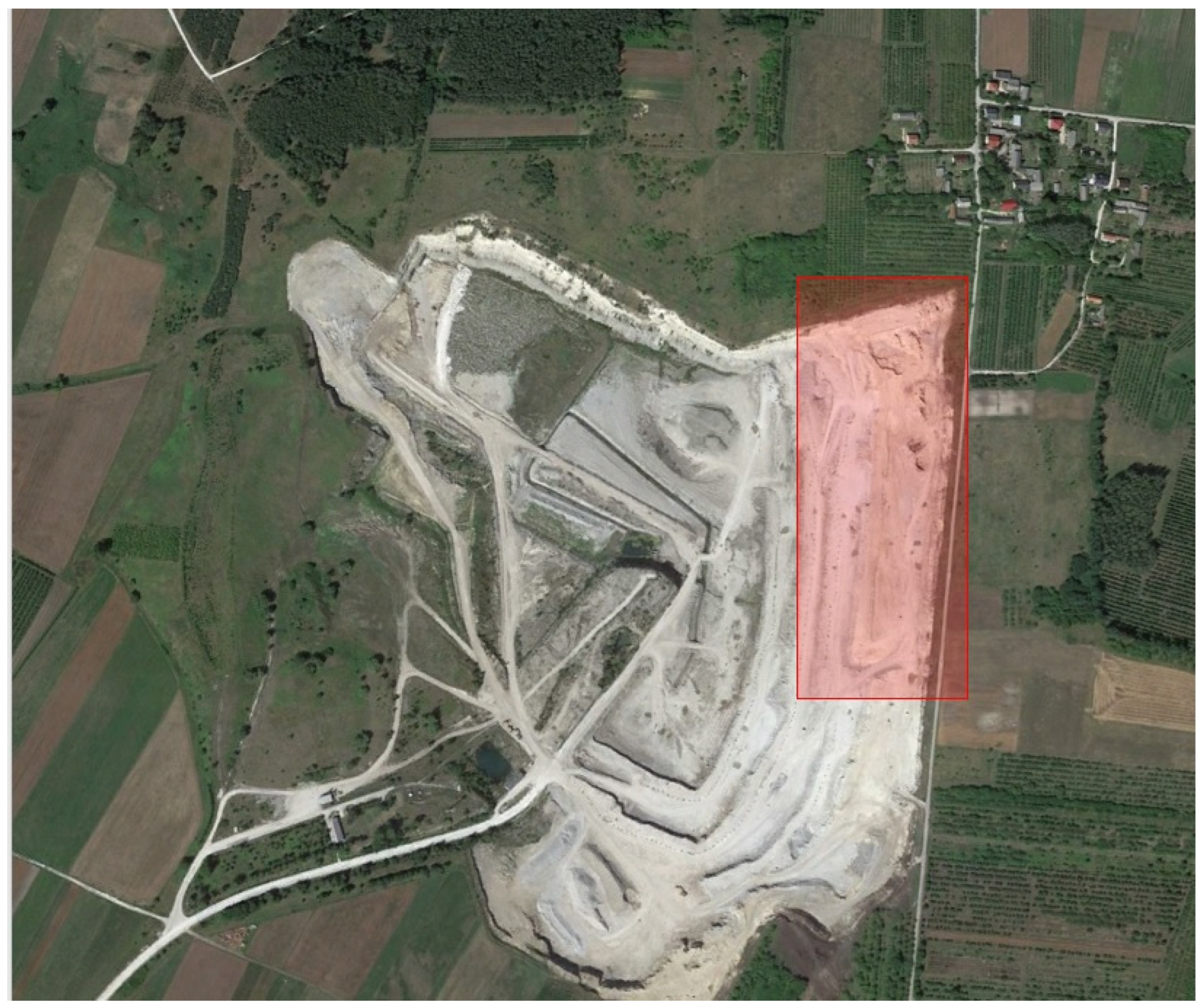


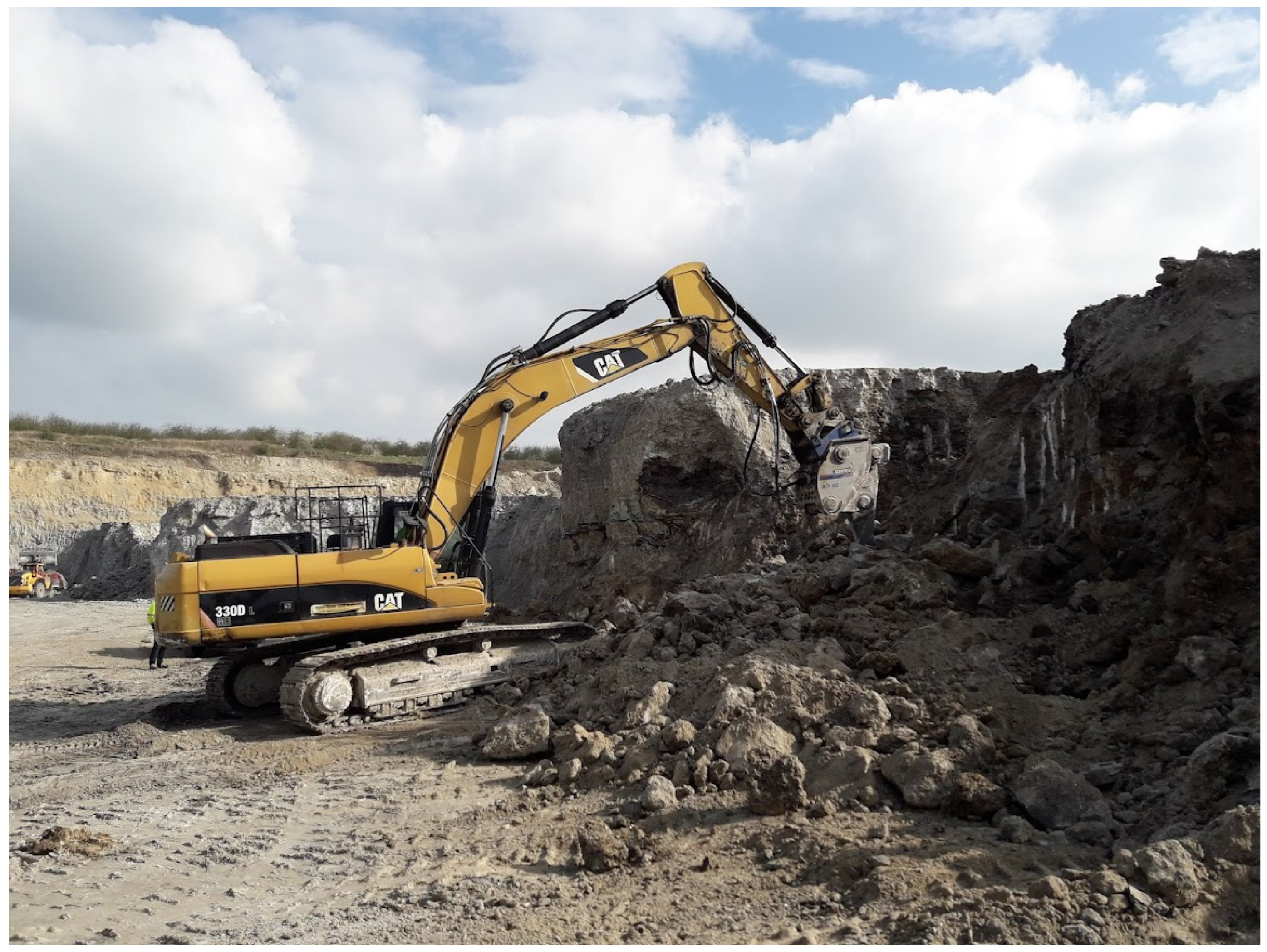

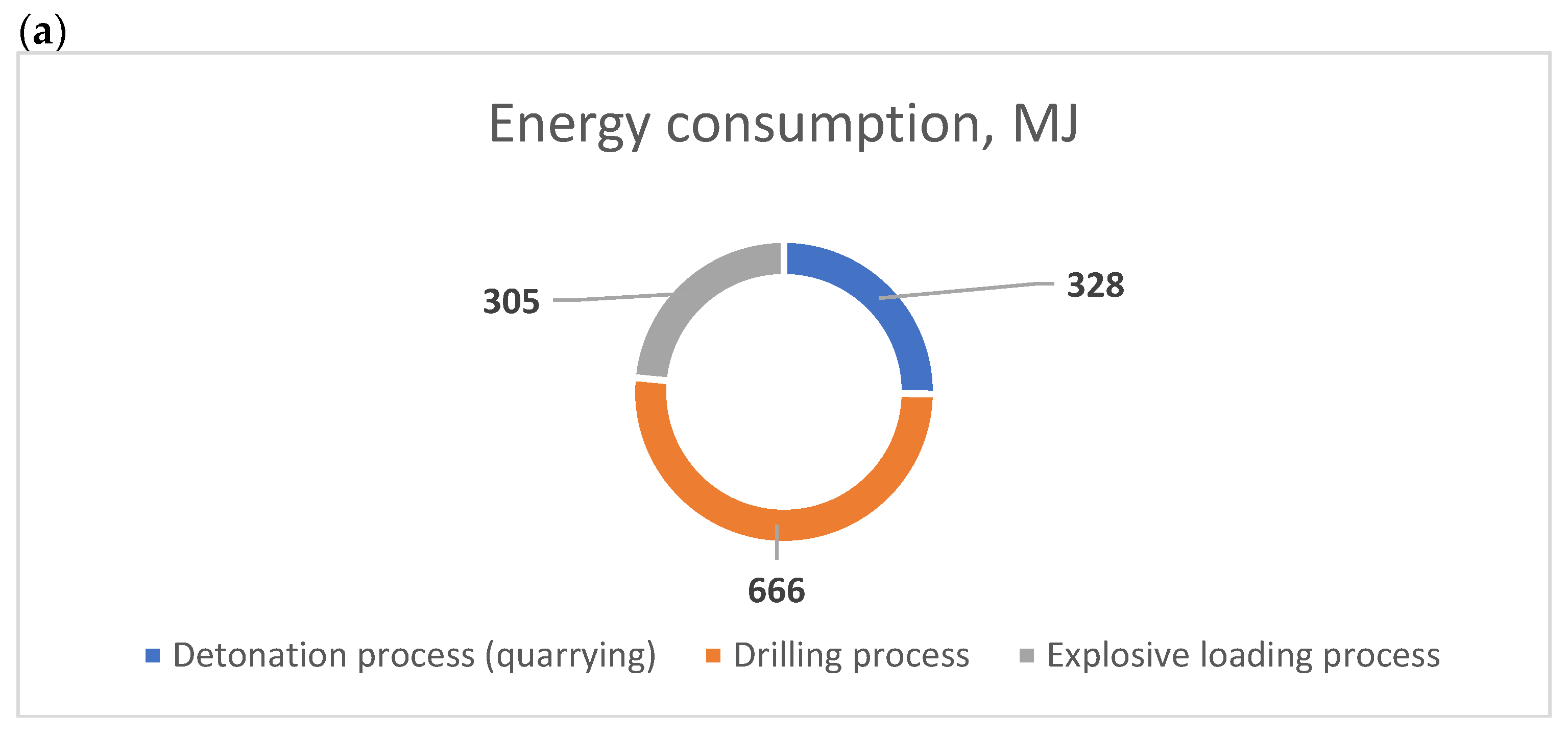



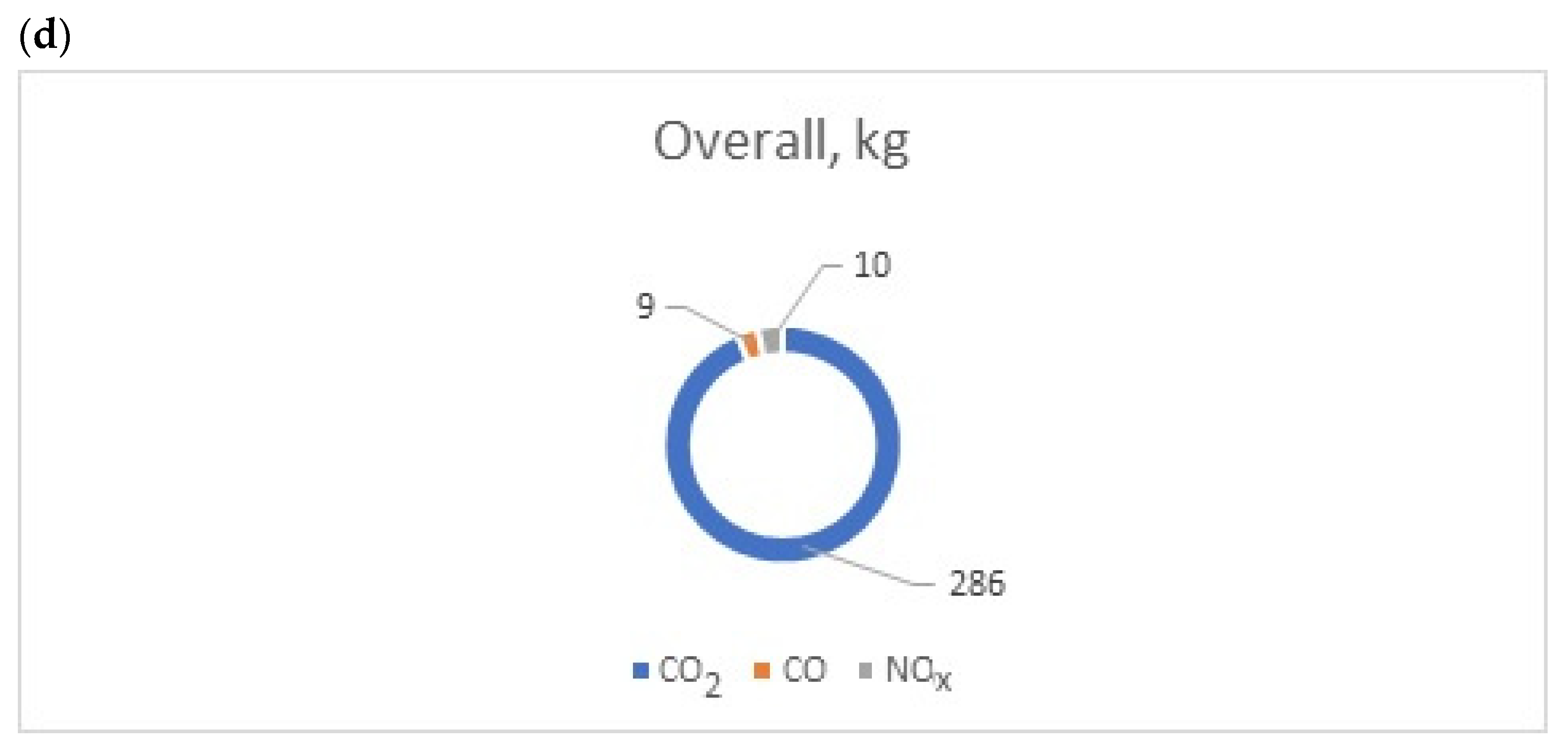
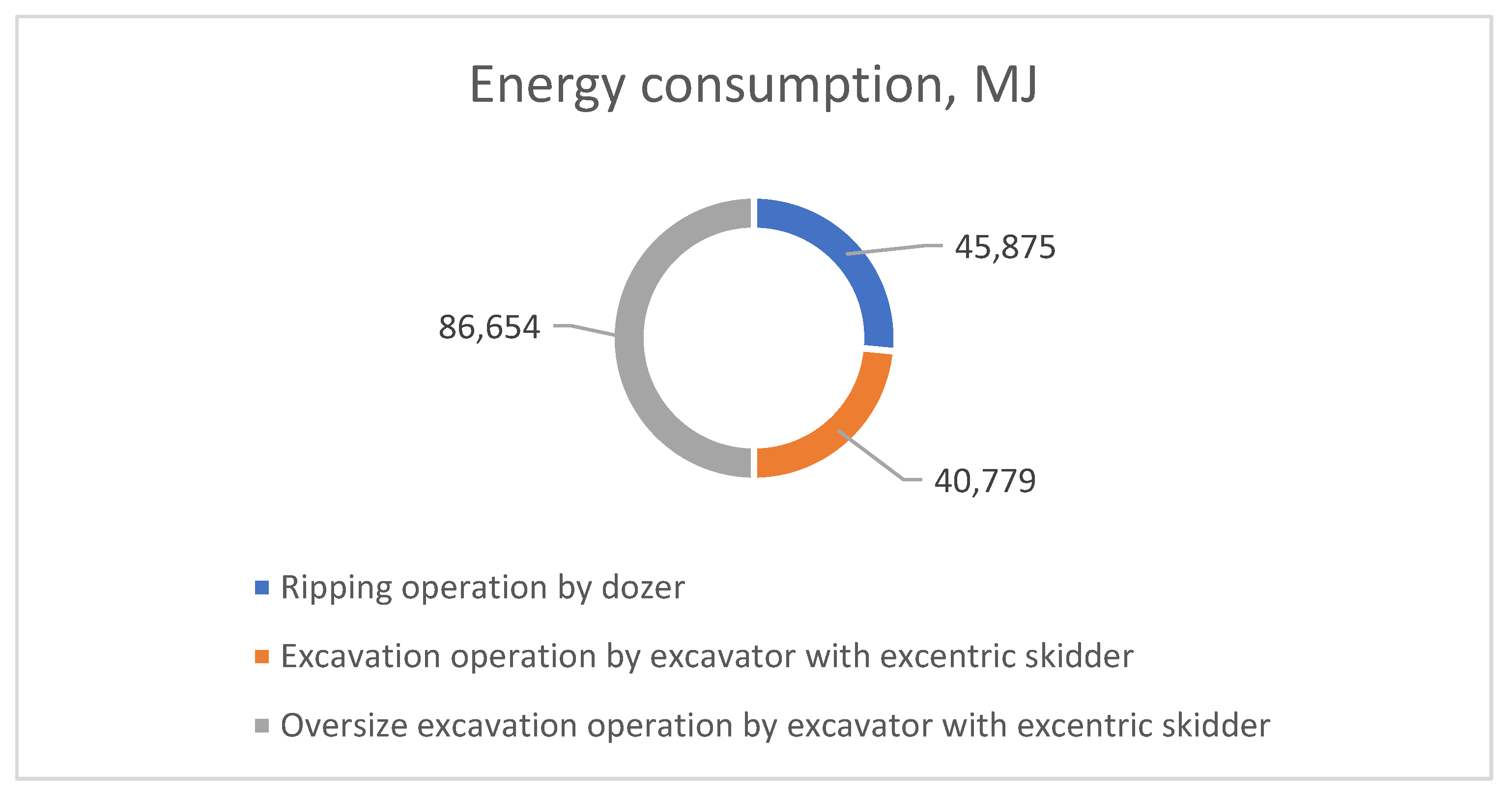
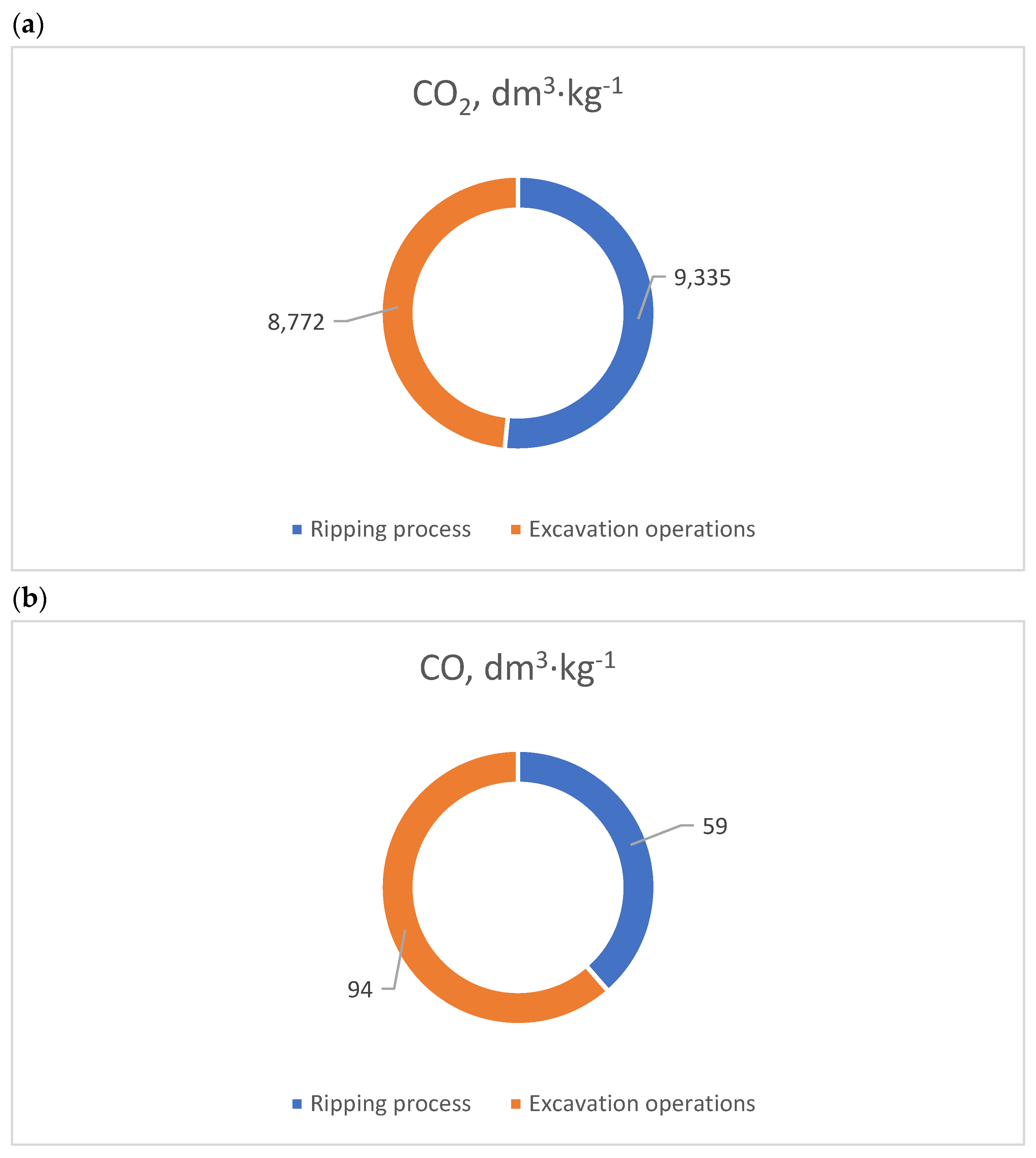

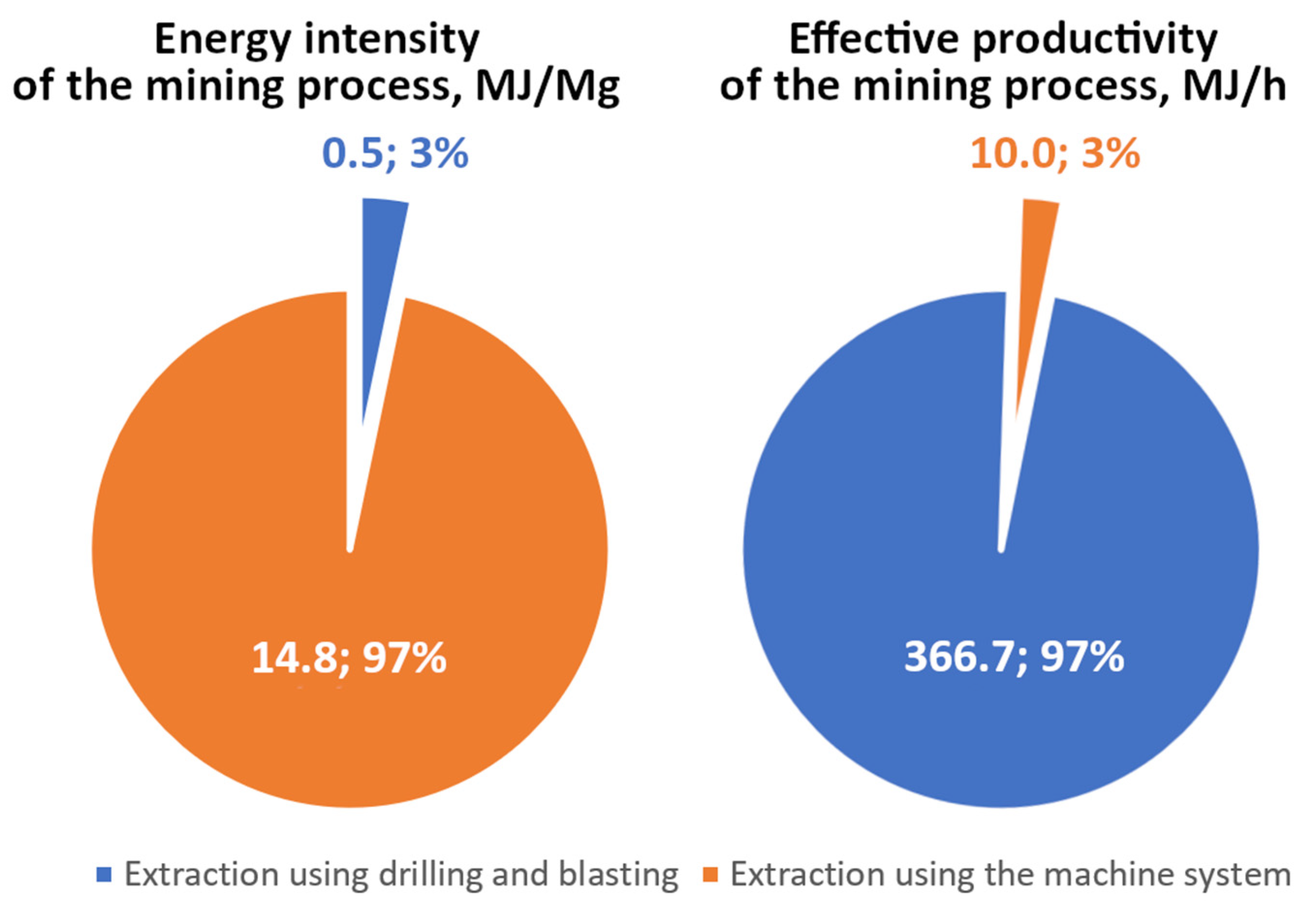
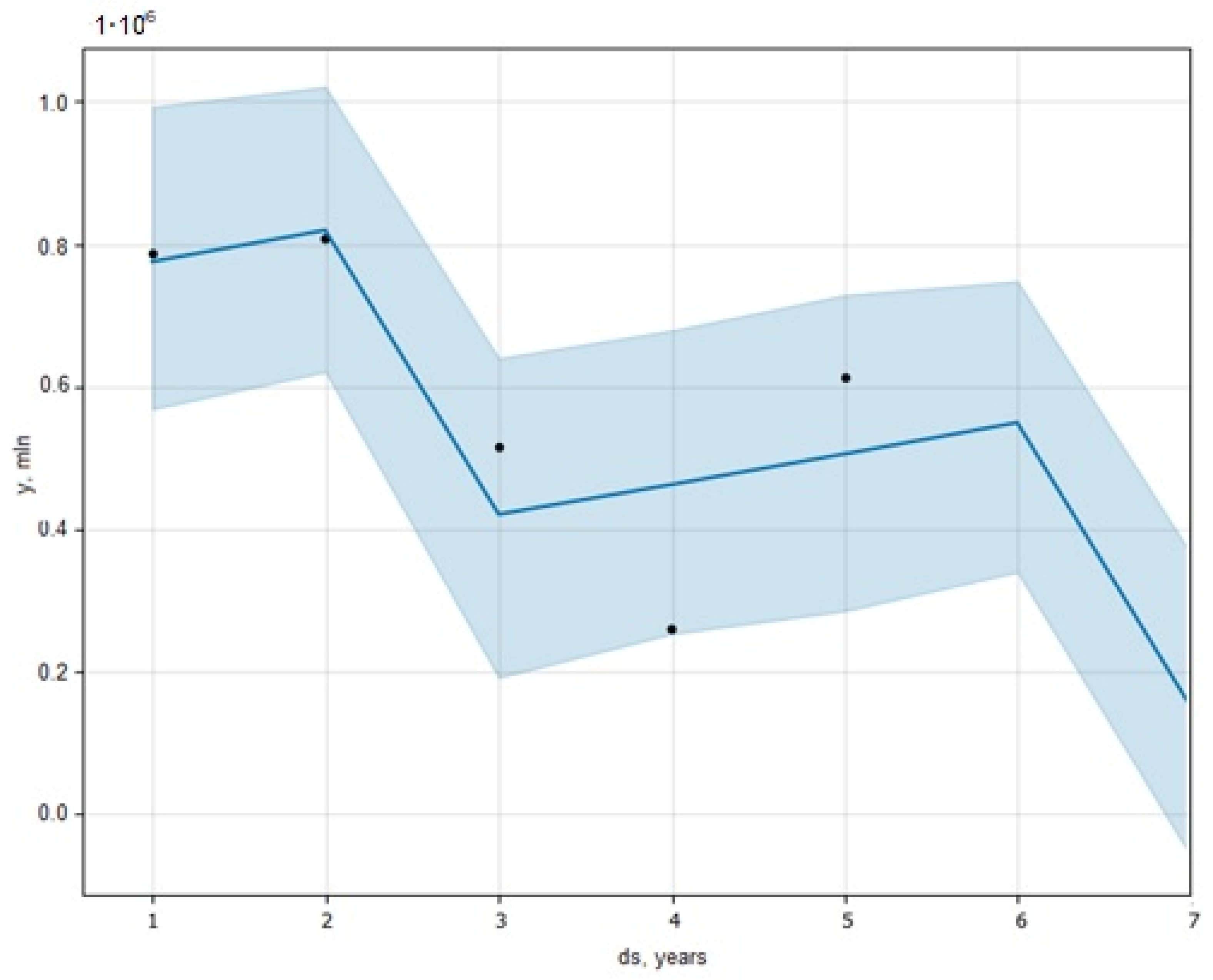
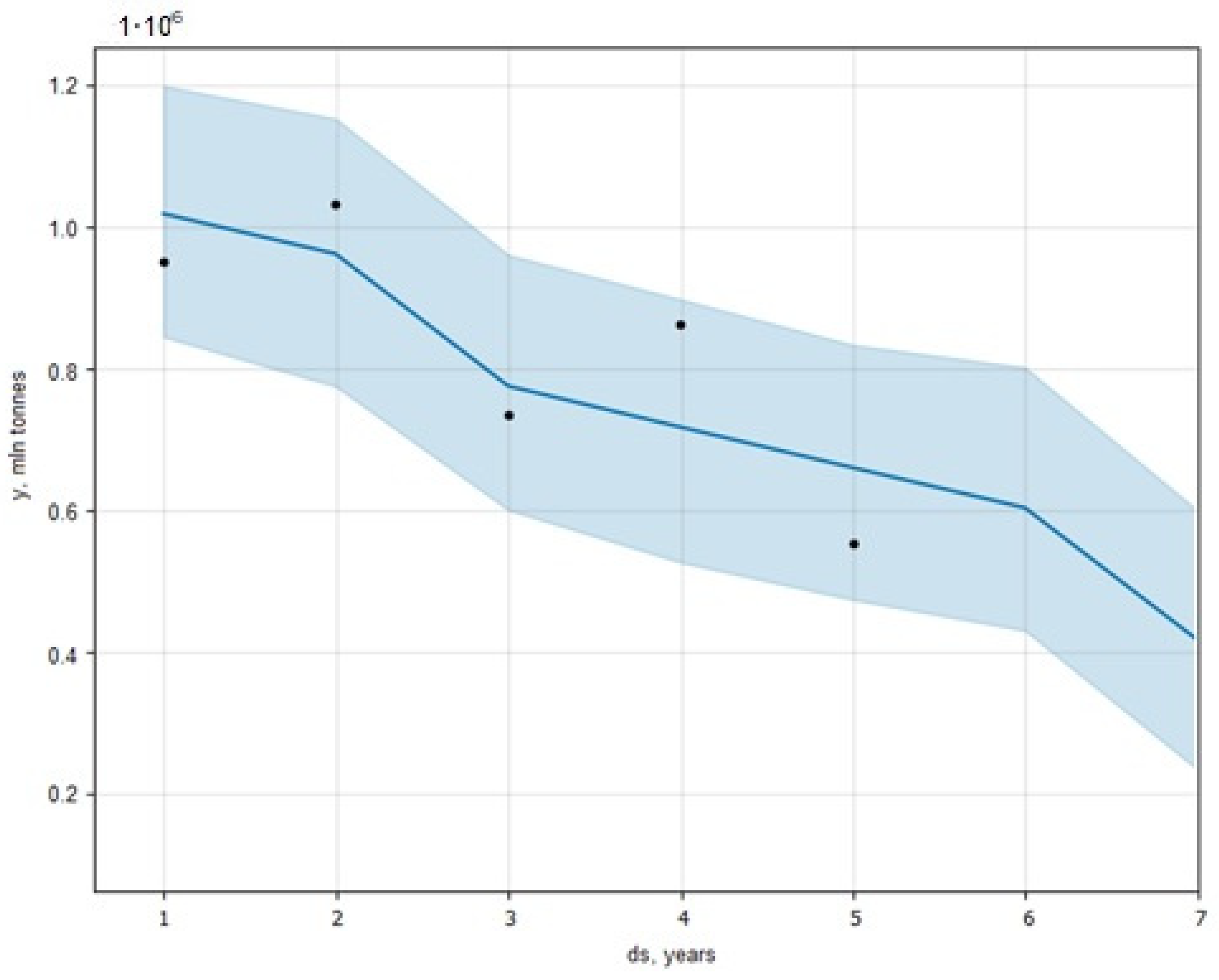

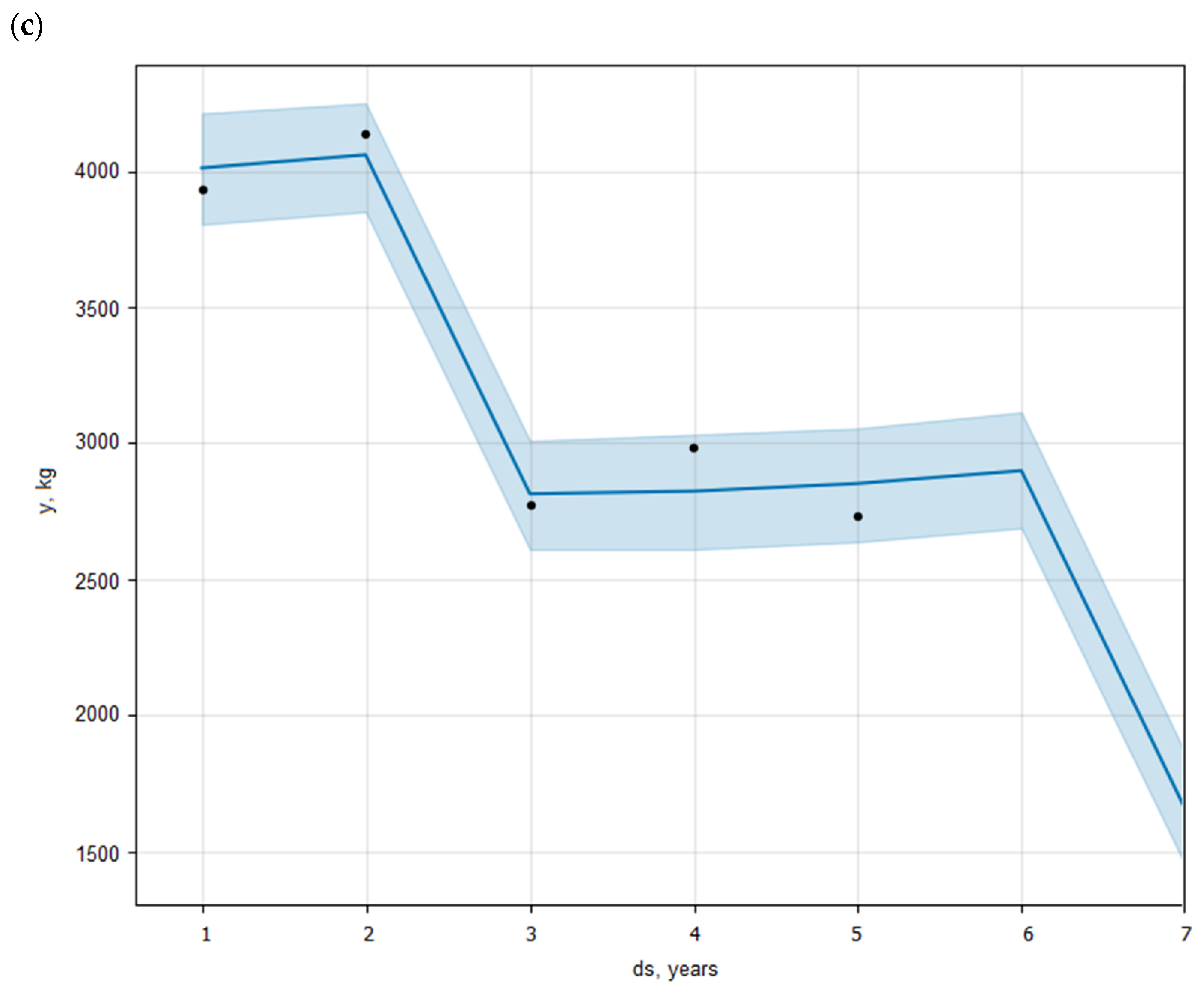
| Name of Parameter | Value |
|---|---|
| Bench height, m | 8.0 |
| Borehole diameter, mm | 95.0 |
| Length of borehole with subdrill, m | 9.0 |
| Stemming length, m | 1.0 |
| Burden, m | 3.5 |
| Spacing, m | 3.8 |
| Mass of explosive per borehole, kg | 37.0 |
| Mass of explosive per delay, kg | 37.0 |
| Total mass of explosive, kg | 407.0 |
| Number of boreholes in series | 11 |
| Number of rows | 1 |
| Gypsum volume, tons | 12,779 |
| Name of Parameter | Value |
|---|---|
| Annual gypsum extraction, tons | 12,779 |
| Bench height, m | 8.0 |
| Burden, m | 3.5 |
| Bench length, m | 41.8 |
| Gypsum volume, tons | 12,779 |
| Parameter | Caterpillar 330DL | Caterpillar D9R |
|---|---|---|
| Annual volume of gypsum extraction, Mg | 6711 | 6068 |
| Value of fuel consumption, l | 32,253 | 26,362 |
| Technical Parameters | Caterpillar 330DL | Caterpillar D9R | Hausherr HSB111-P |
|---|---|---|---|
| Gross power, kW | 200 | 302 | 125 |
| Average diesel consumption, l·h−1 | 22.76 | 26.76 | 12.32 |
| Total efficiency of the powertrain unit η, % | 35 | 37 | 38 |
| Volume of GHG Emissions of Gases | Caterpillar 330DL | Caterpillar D9R | Hausherr HSB111-P |
|---|---|---|---|
| CO, g·h−1 | 300 | 450 | 125 |
| CO2, g·h−1 | 6140 | 7150 | 34,011 |
| NOx, g·h−1 | 648 | 544 | 38 |
| Energetic Material | Average Energy of Explosion, kJ·kg−1 | Maximum Deflection, % |
|---|---|---|
| ANFO | 3940 | 0.5 |
| TNT * | 6400 | - |
| Operation | Energy Consumption, MJ |
|---|---|
| Detonation process (quarrying) | 327.76–481.63 |
| Drilling process | 665.81 |
| Explosive loading process | 305.14 |
| Energetic Material | Amount, dm3·kg−1 | ||
|---|---|---|---|
| CO2 | CO | NOx | |
| ANFO | 144.5 | 16.4 | 13.1 |
| TNT | 919.6 | 11.5 | 4.8 |
| Type of Operation | Amount, kg | ||
|---|---|---|---|
| CO2 | CO | NOx | |
| Detonation process | 126.24 | 7.68 | 10.23 |
| Drilling operations | 109.8 | 0.8 | 0.21 |
| Explosive loading | 50.3 | 0.130 | 0.035 |
| Overall | 286.34 | 8.61 | 10.48 |
| Operation | Energy Consumption, MJ |
|---|---|
| —Ripping operation by dozer | 45,875.4 |
| —Excavation operation by excavator with excentric skidder | 40,778.7 |
| —Oversize excavation operation by excavator with excentric skidder | 86,654.2 |
| Type of Operation | Amount, kg | ||
|---|---|---|---|
| CO2 | CO | NOx | |
| Ripping process | 9334.60 | 58.78 | 71.00 |
| Excavation operations | 8771.68 | 93.56 | 43.31 |
| Overall | 18,106.28 | 152.33 | 114.32 |
| Year | Gypsum Mass, Tons | Energy Consumption, MJ | Amount, kg | ||
|---|---|---|---|---|---|
| CO2 | CO | NOx | |||
| 1 | 804,473 | 949,506 | 192,902.6 | 3398.6 | 3934.1 |
| 2 | 827,956 | 1,031,034 | 209,789.4 | 3588.6 | 4138.6 |
| 3 | 529,479 | 735,154 | 150,017.3 | 2422.8 | 2772.9 |
| 4 | 529,320 | 961,798 | 176,508.9 | 2636.1 | 2983.2 |
| 5 | 619,790 | 552,251 | 111,117.9 | 2315.9 | 2732.5 |
Disclaimer/Publisher’s Note: The statements, opinions and data contained in all publications are solely those of the individual author(s) and contributor(s) and not of MDPI and/or the editor(s). MDPI and/or the editor(s) disclaim responsibility for any injury to people or property resulting from any ideas, methods, instructions or products referred to in the content. |
© 2024 by the authors. Licensee MDPI, Basel, Switzerland. This article is an open access article distributed under the terms and conditions of the Creative Commons Attribution (CC BY) license (https://creativecommons.org/licenses/by/4.0/).
Share and Cite
Biessikirski, A.; Bodziony, P.; Dworzak, M. Energy Consumption and Fume Analysis: A Comparative Analysis of the Blasting Technique and Mechanical Excavation in a Polish Gypsum Open-Pit Mine. Energies 2024, 17, 5662. https://doi.org/10.3390/en17225662
Biessikirski A, Bodziony P, Dworzak M. Energy Consumption and Fume Analysis: A Comparative Analysis of the Blasting Technique and Mechanical Excavation in a Polish Gypsum Open-Pit Mine. Energies. 2024; 17(22):5662. https://doi.org/10.3390/en17225662
Chicago/Turabian StyleBiessikirski, Andrzej, Przemysław Bodziony, and Michał Dworzak. 2024. "Energy Consumption and Fume Analysis: A Comparative Analysis of the Blasting Technique and Mechanical Excavation in a Polish Gypsum Open-Pit Mine" Energies 17, no. 22: 5662. https://doi.org/10.3390/en17225662
APA StyleBiessikirski, A., Bodziony, P., & Dworzak, M. (2024). Energy Consumption and Fume Analysis: A Comparative Analysis of the Blasting Technique and Mechanical Excavation in a Polish Gypsum Open-Pit Mine. Energies, 17(22), 5662. https://doi.org/10.3390/en17225662






